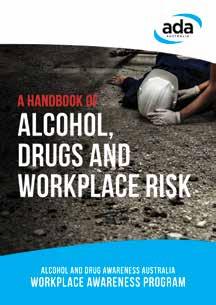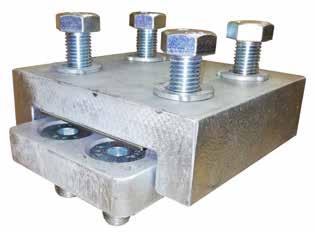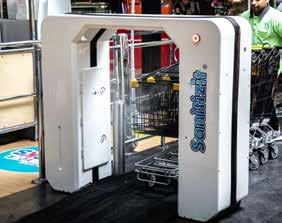
18 minute read
ALCOHOL AND DRUG AWARENESS
$6 BILLION HANGOVER IN THE WORKPLACE BECAUSE OF ALCOHOL AND DRUGS
The cost in lost productivity due to misuse of alcohol and drugs in the workplace sits at $6 billion per year, according to industry statistics referenced by Alcohol and Drug Awareness Australia (ADA Australia), with 2.5 million working days lost.
Advertisement
Digging deeper, 10 per cent of workplace deaths are drug or alcohol related and factor in 25 per cent of workplace accidents. Sixty-one per cent of full-time employees report frequent use of drugs or alcohol. Ten per cent of workers have reported negative experiences with drug or alcohol affected co-workers.
ADA Australia was launched in the hope of greatly reducing those statistics through greater awareness – with an accent on connecting with people with problems before they hit rock bottom and deeper mental problems develop.
As ADA sees it, drug and alcohol misuse reaches into every corner of the Australian community – into workplaces, families, sporting clubs, and professional life. And, alongside, sit the accompanying disorders of depression, anxiety and selfharm. the effects on family and financial security, and the social and workplace impacts, can we begin to address the problem,” Mr Pettiona said.
ADA Australia specialises in training sessions in the workplace, providing positive strategies for ensuring the health, safety and welfare of all employees, co-workers and the community. It also conducts counselling support through to rehabilitation referrals, as well as workplace mental health training.
For companies, ADA Australia also provides assistance in developing a consultative, compliant drugs and alcohol policy as part of a best practice Workplace Health and Safety Management Plan
Employers have a duty of care under the Australian Work Health and Safety Act (2011) to provide a workplace that is free from hazards associated with the misuse of drugs and alcohol.
More than 30,000 workers have attended ADA workshops in the four years since the body was formed, with more 200,000 people accessing ADA support services. Another 70,000 Australian workers are expected to attend ADA training sessions over the next 18 months.
ADA Australia workshops are conducted by presenters with “lived experience” of the personal and public risk of alcohol and drug dependence. This includes:
• Education for increased awareness of the physiological and psychological impact of drugs and alcohol, how these substances impair workperformance and judgment, and the long and short-term damage to vital organs (and to financial security). • Development of positive preventative practices for a safer working environment
• Education and awareness to promote better life choices (around drugs and alcohol) for better health and wellbeing.
• Strategies for dealing with alcohol and drug issues on the worksite (with co-workers, customers or contractors), for fostering an open supportive workplace culture and for best-practice processes and policies to ensure the well-being and safety of affected individuals and co-workers.
Co-founder and non-executive chairman Anthony Pettiona says: “If we are to get to the nub of the misuse of drugs and alcohol, we have to first accept that this is a cultural thing we are up against.
“That means we have to change our ‘thinking’ around these substances, in the way we use them, in the ways they are ‘modelled’ socially and in the media, and in the modelling we do in front of our children.
“At ADA Australia, we believe that by building awareness of the health impacts,
TIPS FOR MINIMISING THE HARMS FROM ALCOHOL CONSUMPTION
• Drink water or other non-alcohol beverages between alcoholic drinks
• Avoid drinking in rounds with friends, as you may end up drinking more than planned
• Order smaller serves of beer, cider and spirits; rather than pints or double serves
• Don’t allow others to top up your glass if you’re sharing a bottle of wine as you may lose track of how many drinks you’ve consumed
• Avoid high-alcohol content beverages, such as stronger beers or wines, and spirits
• Eat some food before and while drinking, to slow your drinking pace and slow the absorption of alcohol • Occupy yourself while drinking to reduce the amount you’re consuming: play pool, sing karaoke, dance, talk to friends.
Avoid combining alcohol with other drugs, including pharmaceutical and illicit drugs
Alcohol is a depressant drug. Consuming alcohol with other depressant drugs such as benzodiazepines, GHB, ketamine or opioids can increase the risk of overdose and cause loss of consciousness, nausea and vomiting.8
Combining alcohol with stimulants such as cocaine, amphetamines or MDMA can also be dangerous, as both alcohol and stimulants can cause dehydration. Additionally, some stimulants can mask the effects of alcohol, leading people to drink more.9 Don’t leave drinks unattended
Drink spiking occurs when a person deliberately adds alcohol or another drug to a drink without the knowledge of the person who will be drinking it. Alcohol is the most common substance used to spike someone’s drink, by adding alcohol to a non-alcoholic drink, or making it stronger.10
To reduce the risk of drink spiking:
• avoid sharing drinks
• buy or pour your own drinks
• don’t accept drinks from strangers unless you are at the bar and can observe it being poured
• don’t leave your drink unattended
• keep an eye on your friends and their drinks
Energy company Zinfra engaged ADA to run its drug and alcohol program across its organisation.
“We entered this program with high expectations after we witnessed the presentation by staff with lived experiences,” a spokesman said.
“The feedback from our staff regarding the program is outstanding and we have numerous examples of the program making a difference in the lives of employees. The program is flexible and was tailored to our requirements and I highly recommend business leaders to take the time to arrange a session with ADA.”
Delta Group engaged ADA to conduct a trial of training workshops with its workforce at various project sites in Sydney.
“The interactive, two-hour workshops facilitated by ADA were received enthusiastically from all participants and reinforced not just our corporate policy and the professional obligations of our workers and contractors, but the deep personal impacts of addiction on family and friends,” Delta Group communications manager Damien Hanger.
“The success of these workshops was such that we are planning a wider roll-out so we can build on our already strong safety culture, but to also provide our workforce with knowledge and skills that may be applied outside of work.”
ADA Australia 1300 378 429 https://adaaus.com.au/
DEALING WITH ALCOHOL OR DRUG-IMPAIRED PEOPLE
When dealing with drug or alcoholimpaired individuals, safety is the first and overarching priority.
This includes:
• The safety and wellbeing of staff
• The safety and wellbeing of the public
• The safety and wellbeing of the affected person.
For people working in customer service, in front counter or sales roles, the likelihood is high that they will encounter or be engaged in interactions with drug or alcohol-impaired customers or visitors to the workplace.
However, dealing with people who are impaired by substance use, emotionally unwell or experiencing a psychotic episode, requires skill and sensitivity.
It also calls for compassion and patience, a level of understanding as to the severity of the impairment (and whether medical or other assistance may be required), and alertness as to the potential hazard and safety risk posed.
People in “front of house” roles, or others likely to encounter drug or alcoholimpaired individuals, should be trained for these interactions – for their safety, as well as for the wellbeing of the affected person.
The nature of the response in these situations can vary with the circumstances of the interaction.
Given the effects of alcohol and druguse on impulse control and the GABA receptors in the brain, and depending upon other factors affecting behaviour and state of mind, interactions with impaired individuals can be difficult.
An aggrieved drug or alcohol-affected customer, client or visitor may pose immediate risk (whatever sits behind their sense of aggravation).
It is important to be aware that any interaction can quickly become volatile, with or without correct handling, escalating rapidly from frustration to agitation and belligerence, and, in worst cases, to threats or acts of violence.
These risks can be heightened when psychostimulant drug-use is involved, such as methamphetamine (ice) and amphetamine (speed), among others. The behaviours of people affected by these substances may be highly erratic, uncontrolled and potentially aggressive.
In high risk environments, therefore, or during higher risk hours (such as late at night), work teams should contain at least one trained person to take the lead in assessing risk, and in taking action or providing direction in the interests of the safety and wellbeing of staff, of customers and in the interests of the affected individual.
It should also be recognised that while psychostimulant drug use can increase risk of aggressive behaviour, not all users become aggressive.
In fact, most drug or alcohol-impaired customers or visitors to the workplace are likely to be compliant and benign, if not readily co-operative. They may also, depending upon the level of impairment, be confused, uncertain, withdrawn and unresponsive.
It is important therefore that all staff engaged in “front of house” roles (in reception, at service counters or involved in sales) – or in any role involving engagement with the public – are trained in correct processes and procedures for managing their own safety when engaging or responding to impaired individuals, in acting to minimise potential risk to the safety and wellbeing of others present, and in acting in the interests and welfare of the affected individual.

SORRY RECORD OF ALCOHOL AND DRUGS IN THE HOME
Australian research into the scourge of family violence shows a strong causal link between the misuse of alcohol and drugs, and violence committed against partners and other family members.
While people not alcohol and drug-affected also commit these terrible acts, the research confirms what many of us know to be true: that much of this violence is fuelled by alcohol and drugs.
The damage it does to families and communities clearly shocks and horrifies clinicians, police and other frontline service providers working close to the problem.
“The level of alcohol-related damage occurring in our communities is simply appalling. The health, social and economic costs associated with alcohol use cannot be allowed to continue at the current level,” said Dr John Herron, chairman of Australian National Council On Drugs.
Research conducted by the National Drug Law Enforcement Research Fund (NDLERF – Alcohol/Drug-Involved Family Violence In Australia 2017) shows that alcohol and/or drugs are involved in more than 40 percent of family violence incidents reported to police. The same report shows that of drug-related family violence incidents, 43 percent resulted in physical injury.
For those incidents involving police call-outs and intervention, the offenders are predominantly male, and the victims predominantly female.
It is to Australia’s shame that too many women are terribly injured, too many lose their lives, and too many children suffer physical and mental harm at the hands of drug and alcohol-affected perpetrators.
The scarring on children is welldocumented. Co-author of the NDLERF Report, Professor Peter Miller, said: “Key challenges … include the intergenerational nature of the cycle of violence, and the devastating impact it has on children in families who suffer such violence.”
While the misuse of drugs and alcohol is “normalised” across much of Australian society, we are fast running out of excuses for the damage these substances do.
ADA Australia is committed to raising awareness of the impact of drugs and alcohol on the health and wellbeing of Australians, on their families, on their financial security, and on the risks drugs and alcohol pose to workplace health and safety.
GLIDING STRUCTURAL BEARINGS DELIVER EXTREME PERFORMANCE
Custom-fabricated structural bearings are being introduced by Hercules Engineering for extremely high stress applications requiring outstanding loadbearing performance, even in compact or wet spaces of buildings and industrial structures.

The latest Herculon™ structural bearings are manufactured by integrating H-Glide fibre-reinforced composite pads sliding on 2B finish stainless steel to achieve an exceptionally low sliding coefficient of friction compared with other engineering bearing materials.
Unlike metal bearings that may rust or require continual lubrication and maintenance, the environmentally safe yet hard-wearing H-Glide bearing pads are dry sliding and will not release contaminants into surrounding environments or adjacent processes.
Mr David Booty, manager, Hercules Engineering (a division of Cut To Size Plastics Pty Ltd) said: “H-Glide’s excellent sliding properties (including friction coefficients from 0.05 – 0.1) are invaluable to architects, engineers and specifiers because lower coefficients of friction will transfer less stress onto the load bearing structural components when the bearing does its job of protecting them against surrounding movement.”
Hercules Engineering and Cut To Size Plastics provide a wealth of experience and application guidance, based on almost 50 years of operation in Australasian and Asia-Pacific regions in applying engineering polymer technology to construction, infrastructure, food and beverage, energy, mining, manufacturing, maritime, oil and gas, safety and water and wastewater applications.
“With their incompressible H-Glide sliding layer, these bearings can withstand extreme point pressures of 350-500 megapascals, depending on bearing design and application,” Mr Booty said.
“This outstanding performance – which is up to 40 times greater than conventional water-resistant and non-lubricated fibrereinforced elastomeric bearing pads – is complemented by the material’s ability to function well in a variety of environments including, but not limited to, damp or under water applications. It is suitable for:
• Construction, infrastructure, engineering and architectural projects involving high point loads on bearings, including commercial, retail and public infrastructure ranging from health facilities to parking stations
• Oil process and production platform applications, as well as resource development infrastructure and mineral processing plants subject to changing operational loads and ambient conditions
• Maritime and logistics structures, port and rail facilities, water and wastewater environments requiring a combination of high engineering performance combined with environmental compatibility
• Energy structures, including wind, wave and tidal power generators, where bearings must provide outstanding performance over varying loads for extended periods.
• Industrial and manufacturing process plant, including food and beverage, plant and process engineering applications requiring low maintenance, with high requirements for safety and hygiene
“A major advantage of this type of composite bearing is that they do not require lubrication, which minimises any disruption to processes,” Mr Booty said. “H-Glide bearings’ already excellent lifespans can be increased by the use of a mirror polished stainless steel sliding plate.
“Absorption of water and other fluids is negligible. The material is virtually inert, reactions with food and cleaning substances, for example, almost never occur,” Mr Booty said.
The company’s standard ranges of Herculon™ structural bearings and Hercuslip™ composite slip joints are widely proven product designs that have performed over decades since 1972 in applications ranging from landmark metropolitan construction projects, through to major international industrial and resources projects.
The new custom bearings that incorporate H-Glide are a new extreme performance addition to Hercules Engineering’s easily installed and costeffective range of products that gives architects, engineers and specifiers a high performance and more durable bearing option.
H-Glide technology is being incorporated into Herculon structural bearings custom-fabricated for extreme loads. The material is proven internationally.
Hercules Engineering’s latest example of bearings incorporating H-glide was in a shopping centre roof which required extreme load-bearing capacity in a confined space, as close as possible to the axis of the load.
The H-Glide bearing pad is available in different formulations, including conductive materials. It is equally suitable for a wide variety of high-load structures requiring extreme load-bearing capability combined with non “stick-slip” behaviour, where static and kinetic coefficient of sliding friction are virtually equal.
“By using new generation composite formulations, H-Glide bear¬ings allow the highest loads, with ultra-low wear rates and friction values,” Mr Booty said. “The material is resistant to a majority of common industrial chemicals and environments, whether it is immersed in water or used in dry applications, or anywhere in between, from freezing to tropical conditions.”
TRAPEZOIDAL THREADS AND NUTS
Trapezoidal threads are a common screw thread profile offering high strength with ease of machining and assembly.
Typically these threads are found where large loads or accuracy is required, as in vices where the thread is used to supply compressional holding force, or the lead screw of a lathe where the thread is used to convert rotational motion into linear motion.
Trapezoidal thread and nuts are power transmission screw threads similar to the Acme series but made to metric dimensions and standards instead of imperial sizing.
One subtle but important difference between Acme and Trapezoidal thread is the flank angle. Acme threads have flank angles of 29° whereas Trapezoidal threads have 30°.
All trapezoidal thread have lead angles of 5° or less making them self locking, therefore the screw will not back-drive under most conditions, eliminating the need for brakes or other holding devices.
T.E.A. Transmissions’ standard range of threads are cold formed using a unique, highly accurate thread rolling process which guarantees a smooth, high quality thread.
The range of applications for T.E.A. trapezoidal thread spindles is expanded, as it is possible to choose from threads produced from steel or stainless steel.
T.E.A.’s standard steel material is C15 or C45 on request, also in 304 stainless standard and 316 stainless on request with nuts produced from bronze, steel or stainless steel also. Nuts are available in a range of round, hex, flanged and square types to accommodate your application.

Steel nuts however, are not intended for motor driven motion screws. For this duty bronze nuts provide the superior service and at a higher working loads. T.E.A.’s stock range now includes both right and left forms with some sizes being available in lengths up to 3000mm.
T.E.A. Transmissions Pty. Ltd. 07 4129 2533 www.tea.net.au
ATSE FLAGS TOP PRIORITIES FOR THE MODERN MANUFACTURING STRATEGY ROADMAPS
SAGE GROUP LAUNCHES AUTOMATED SHOPPING TROLLEY SANITISER
Resources technology, recycling and clean energy are among four areas nominated by an Australian think tank to lead the federal government’s manufacturing strategy.
The Academy of Technology and Engineering (ATSE) says targeted support and investment in Australian medical technology, including in digital health records, should be a top priority of the government’s Modern Manufacturing Strategy (MMS).
The academy shares the strategy’s vision for Australia to be recognised as a high quality, sustainable manufacturing nation, and argues that targeted and strategic investment in technology would catalyse this transformation.
ATSE’s submission to the government’s consultation on the MMS Roadmaps highlights the four areas of the strategy where Australia’s established global credibility, competence, skills capability and natural advantage could be swiftly leveraged to create jobs and economic growth.
These are medical products, recycling and clean energy, resources technology and critical minerals processing, and food and beverage.
However, ATSE’s submission cautions that while Australia needs to innovate and create new industries to recover from the COVID-19 pandemic, the MMS should also support and grow existing manufacturing to leverage Australia’s skilled workforce and current capabilities.
ATSE’s report on technology readiness in the healthcare sector shows that the digitisation of health records is the most critical priority for Australian health technology. Support is also needed to improve the commercialisation pathways of all Australian-designed medical technology.
Recycling and clean energy are separate challenges and ATSE believes they should be given their own dedicated streams in the MMS.

ATSE’s new technology readiness report on the waste management and resource recovery sector will show that strategic investment in this sector would help SMEs adopt new technologies to help Australia transition towards a waste-free future.
ATSE believes Australia’s priorities for clean energy technology should focus on long-term and resilient solutions, including low and zero emissions electricity.
Automation and industrial company SAGE Group has launched a new automated machine capable of sanitising entire trolley lines.
A first of its kind, the ‘Sanitizit’ will be installed at supermarkets and is capable of cleaning the whole trolley, not just the handles. It can also be used in airports and hospitals.
SAGE CEO Adrian Fahey said the company will manufacture and support installation of the devices, after a chance discovery.
“I was fortunate enough to come across this product in the USA through one of our partners,” said Mr Fahey.
“Our team have since worked closely with the inventor to adapt the product to suit Australian conditions and requirements.”
Fahey said: “SAGE has always been at the forefront of innovation and I think this is another great example of this.
The first unit is installed for testing in a Drake Supermarket in South Australia.
“We can put a run of trolleys through and it puts a fine mist across the whole trolley, not just the handles but the whole trolley,” supermarket owner John-Paul Drake said.
“That mist kills 99.9 per cent of all bacteria.”
Drake Supermarkets plans to roll the units out across its 42 stores, while SAGE is working with a number of other supermarkets nationally for future trials.
SAGE Group formed an exclusive partnership with Sanitizit for the manufacture, lease and service of the sanitising systems throughout Australia and New Zealand.

Test Machines Australia are your tes� ng machine experts. We off er Australia wide service and support as well as repairs to all makes and models of various tes� ng equipment.
WE OFFER 24 HOUR REMOTE SERVICE & TECHNICAL SUPPORT







